Together in tragedy
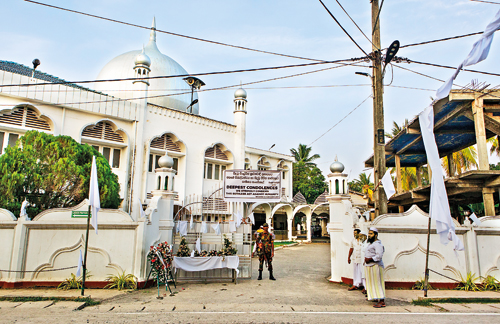 Where do we begin to tell the story of the tragedy, the anguish, the shock, the support, the strength and the reconciliation after the massive terrorist bomb blast on Easter Sunday in Katuwapitiya.
Where do we begin to tell the story of the tragedy, the anguish, the shock, the support, the strength and the reconciliation after the massive terrorist bomb blast on Easter Sunday in Katuwapitiya.
Having walked the length and breadth of this mainly Roman Catholic village where they are still burying the dead or having buried their dead are in deep mourning, we will begin with two parallel roads.
These two roads, both branching to the right off the main Negombo-Chilaw Road, are heavily decorated with white flags and bunting as also proclaiming through huge banners sympathy over those men, women and children who succumbed in this dastardly attack and empathy for those left behind, the survivors with physical and psychological scars.
One road is the Katuwapitiya Road, leading to the Catholic village where there was a massacre of the innocents in their very own church and the other is the Jumma Masjid Mawatha, heavily populated by Muslims with two mosques off it, leading to Periyamulla.
We see flowers all over.

Maha Palli in mourning: White flags and banners at both the Grand Mosque (left) and St Sebastian’s Church (above). Pix by Sameera Weerasekera
Not only the white, yellow and green arches which still stand in the forlorn altar of St. Sebastian’s Church before a congregational area where the pews are overturned on blood-splattered floors and bits and pieces of human remains still cling to walls; pots of white flowers bobbing up and down in funeral processions; white, purple and other wreaths atop coffins in hearses or graves at the cemeteries where 30 or 40 have been buried but also sheaves and pots placed at the gate of the Grand Mosque.
We also hear echoes and re-echoes from the Catholics and the Muslims resonating loud and clear – the “thrasthawadi” (terrorists) need to be hunted down, with the law coming down on them fast and hard, so that there will be no more deaths, injury, moaning and wailing.
Both communities are adamant – they have lived together for long years and there is no disharmony among them. “The Muslims among us cannot be blamed for thrasthawadi violence,” say the Catholics.
The stories of the tragedy are similar but very personal as well. Every by-lane in Katuwapitiya has one, two or more homes where death through a suicide-bomber has paid a visit on Easter Sunday, the day Christians believe Jesus Christ rose from the dead, after his crucifixion on Good Friday.
Some parents attended the Saturday night mass at 7 p.m. and escaped the hand of death, as did some children. But other parents and children went for the more colourful morning mass, for it was to be followed by a procession through the streets of the village, with the chariot carrying the statue of the Risen Christ.
The whole village had laboured for this day – having passed through 40 days of Lent, a time of reflection, sacrifice and preparation for Easter, considered the holiest festival in the Christian calendar. They had cleaned the church and decorated it…..and the sprinkling of Muslim families in the village would also step out of their homes to see the procession pass-by.
Now the church is shut and yellow crime-scene tape cordons it off, the gates are barred and little knots of priests and nuns speak in whispers. Just as we arrived on Wednesday morning on foot, having parked our vehicle a distance away, the Papal Nuncio Archbishop Pierre Nguyen Van Tot, the Ambassador of the Holy See, was just about to drive away, having paid a visit here.
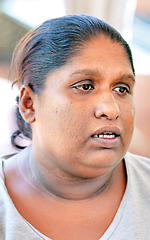
Roshica
There is a heavy presence of armed security forces personnel and barricades everywhere. We trudge to a coconut estate, part of which is now a cemetery, as the cemeteries in the area cannot cope with the demand and there we see graves and more graves, all with simple wooden crosses and flowers. The crosses have a distinct number, and we count from 1 to 32, while people in white and black stream in, to be frisked at the entry point and later weep at the graves.
It is not over yet – the backhoes are ready, as are the shovels leaning against the side of a huge dug up area, awaiting more burials.
Ranjith Jayawardena who had donated these 38 perches to the church a while ago and which have now become the resting place for the blast victims explains how Katuwapitiya is a “big” parish. There are three small and one large church and St. Sebastian’s Church which celebrated its 150th jubilee a few months ago on January 20, is the “maha palliya”.
“People from far and wide come for the Pasku Mangalya,” he says sadly, looking at the graves.
As we leave with heavy hearts, we meet a funeral procession. An adult’s coffin in the hearse, while the mourners hold high a tiny coffin and bystanders tell us in subdued tones that it is a grandmother and granddaughter. A family of five attended mass that fateful Sunday – a mother, a daughter and the daughter’s three children. At communion time, the daughter handed over her baby to the mother and the baby remained with her. The blast left infant and grandmother dead.
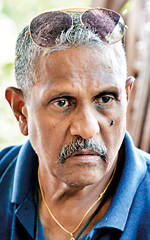
Suraj Fernando
From a small hut by the roadside, we are handed bottles of water at no charge, for the noonday sun is unbearable. We also see donations being brought to the church.
It was around 8.45 that the blast took place, says a young woman, who declines to be named or photographed, with the whole family inviting us into their home after checking our press identity cards.
“Loku Amma and I were together when there was a streak like lightning,” she says, explaining that her two brothers had also helped in the service. One had gone to the rear of the church in preparation for the procession as the mass was drawing to a close.
“Dong-gala pipuruwa,” one boy says.
The whole family is relieved that they escaped unhurt, even though relatives rushed from their home close by and searched among the bodies thinking that they too had died.
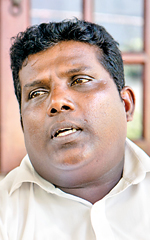
S. Jude Prasad Appuhamy
The young woman says the whole area was covered in smoke and the roof-tiles began raining down on them. Her heart was throbbing and her brother embraced her and they rushed out.
Now in the village “adiyen adiyata mala-geval”, she says, pointing out that there are houses, every foot of the way, with funerals.
“Hondama aya giya (the best people are gone),” she murmurs, as she gives us the toll – a woman and her three children; a woman, her leli (daughter-in-law) and two grandchildren; a mother and daughter; two young people about to marry; and one twin, leaving the other in inconsolable grief.
The image just before the blast is quite clear – the mass had nearly ended, the priest had given the isthuthi kathawa, when someone wanted to thank the priest in return. The priest then made the sign for the people to sit, when the blast occurred.
We need no directions to the other homes, but just follow the banners and the white flags.
“We have lost a bright little boy,” says Suraj Fernando with much emotion. Easter Sunday morn saw his sister and brother-in-law, Manel and Callistus Fernando, going to church along with their daughter and son-in-law, Dilani and Ranjeeva Silva and their three sons, Dimitha (16), Enosh (11) and Gavin (6).
Our chubby and intelligent boy is no more, says Suraj, explaining how his sister and her husband sat somewhere at the front of the church and her daughter’s family about four pews behind. Dilani’s pew was a bit of a tight fit and they asked Enosh to sit with his grandparents.
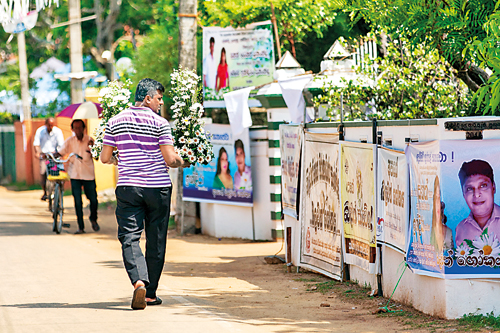
A mourner carries flowers to a funeral down the lane
As fate would have it, that was the side from which the suicide bomber entered the church, taking the three lives, leaving behind an unbearable emptiness right in the middle of this young family, the other members of whom were also injured.
“Hema thenama mehemai. Mulu gamama andanava,” says the older couple’s daughter-in-law, Sandamali, giving us another case where the husband is abroad and the wife and two daughters are dead, with no one even to identify their bodies.
Others tell us of whole families arriving in church in their cars, with only the cars being left behind and homes where the gates are padlocked since Sunday and will remain so forever.
Pathetic is the plight of S. Jude Prasad Appuhamy, who with such love and devotion prepared the chariot for the procession. Seven of his close family are no more, while his wife and one daughter sat in the podi palliya (wing), fortunately not the wing through which the bearer-of-death came. His other daughter was in the middle section but still a distance away.
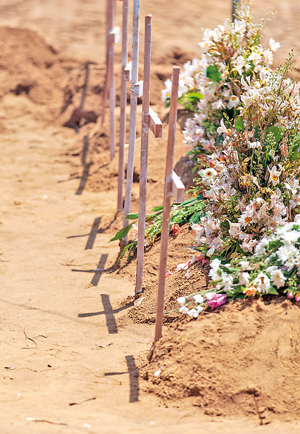
Crosses and flowers: A row of graves at a coconut property now a cemetery
Jude’s elder brother, Dulip Shantha Kumara, and his son, Vimukthi, and daughter, Sajini, and his younger sister, Rashika Dilrukshi along with her two daughters, Sajini and Salome, and son, Shalom are all dead.
“We buried them this morning (Wednesday),” he says tearfully.
Families torn asunder and we hear from son and daughter, Malith and Roshica, how their parents, Rohan and Shanthi Wimanna, went to church that morning.
While Malith and Roshica went for the Saturday evening mass and were sleeping that morning, “Ammi came and got me to help her wear her chain,” remembers Roshica.
They were woken up by a “batto saddayak” and thought the procession was about to start. It was the bomb.
Into their home, while we are talking walks a woman with her face lined with sorrow and hugs them close.
“That family lost their daughter who was in her 20s,” says Roshica, while Malith tells us how the suicide-bomber had walked in and stood near his parents. “You can see them in the video footage. Thaththi was wearing a dark blue long-sleeved shirt and Ammi was in a mal-mal (flowery) top,” he says, adding, “katha karala wedak ne”.
As this village buries its dead and attempts to limp back to a semblance of normalcy, what they seek is not revenge, for many mention the love and compassion of Christ and that they are His followers.
But, Katuwapitiya does want answers from the authorities and they want justice and law and order to prevail, for those who have been left behind not only in their village but in the whole country.
| We have always lived in unity | |
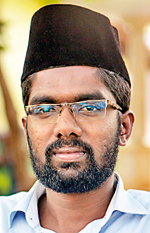 Moulavi Tahir Ahmad We stop by the two mosques along Jumma Masjid Mawatha. “This has never-ever happened in this area and we have lived in unity,” says the Moulavi of Negombo’s Grand Mosque, who has served the ‘Maha Palliya’ for 40 long years. Reiterating that it is a “thrasthawadi kriyawak” and they condemn it wholeheartedly, he explains that nowhere in the Koran or any holy book is there mention of freedom to take the life of another. He urgently called for the identification of the thrasthawadi and their punishment. Meanwhile, Moulavi Tahir Ahmad of the Masjid Fazal stressing that all religions preach the need to do good to others, says that there is no religion which espouses hatred. “Some people are trying to entangle thrasthawadaya with religion but there is no such mathayak in Islam. They are attempting to hide behind religion to commit heinous crimes and we can assure that Islam does not propagate such ideas,” he said, adding that Muslims have always co-existed in peace and harmony with all Christians, Buddhists and Hindus.
|


